Table of contents
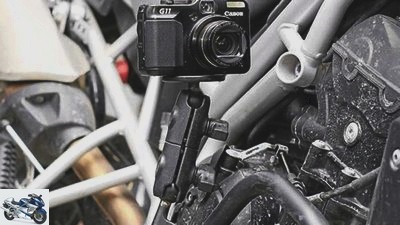
Dentges
accesories
Product test photo equipment for motorcyclists
Photographic equipment for motorcyclists
Comparison test: digital compact and reflex cameras
In front of the camera, i.e. on a motorcycle, everyone feels like an action hero. However, hobby photographers can only capture this action behind the camera if they have sufficient photo equipment and specialist knowledge. MOTORRAD shows how bland motorcycle photos are a thing of the past.
Thorsten Dentges
02/02/2012
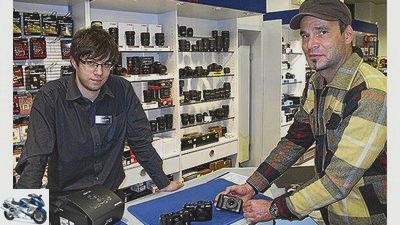
Dentges
MOTORRAD tested digital compact and SLR cameras.
It is often said: Many megapixels, i.e. higher resolution, means better image quality. Wrong or not properly explained. It is true that a higher resolution usually allows a larger output size, but that does not say anything about the quality (detail image, drawing, contrasts, color representation, etc.). Particularly in poor lighting conditions, mini-sensors result in “jittery” images with a lot of so-called noise. In comparison, high-end compacts with larger sensors score better across the board when it comes to “image quality”, although some of the more expensive cameras “only” have ten megapixels (MP) – in contrast to the fat 16 MP for less than 100 euros. Main reason: Good images are still created through good optics, which are usually the result of a clever combination of different lenses.
Buy complete article
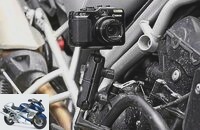
Photographic equipment for motorcyclists
Comparison test: digital compact and reflex cameras
8 pages) as PDF
€ 2.00
Buy now

Dentges
With the EdelKompakten: motif captured, pronounced contrasts, no dynamics.
That takes space. The telephoto lenses for semi-professional digital single-lens reflex cameras (DSLR) weigh between 500 and 1500 grams, while the lightest compact cameras, including electronics and housing, only weigh around 100 grams.
Any technical novice can probably imagine that with the small notches, major compromises have to be made in terms of image quality. If a 50cc moped is to compete against a 1000cc superbike machine, the chances of winning are unevenly distributed. And, to stay with the motorcycle image, if the popular opinion is that there is no substitute for displacement, then the following applies to photo cameras: the more light that can hit the sensor (with analog cameras: film strips), the better the performance. But it is not quite that simple, because just like electronic injection, a good design, light engine parts and so on, the performance can be increased by, for example, higher speeds, the size and quality of the sensor chip and the processing power of the processor can improve the imaging performance of modern digital cameras raise. In any case, it was noticeable with the eight entry-level cameras up to a maximum of 200 euros that there are such big differences in image quality, while almost all candidates in the up-market class between 200 and around 500 euros consistently deliver fine images.
The performance of these cameras is sufficient to put your motorcycle in the right light for display on the Internet or for photo books. And at MOTORRAD, too, these cameras are successfully used professionally, be it to have a compact “handgun” in store for hidden and quick snapshots in travel stories, or to document conspicuous details during motorcycle and accessory tests on the go. The noble ones are two to four times more expensive than the small snaps, but the photos are – to put it bluntly – in the end twice and three times more awesome. With an assumed useful life of around four years and an average of around 1000 images per year, you only have to add a few cents per photo. A clear message: an investment that is worthwhile. On the other hand, those who seriously want to get into action photography cannot avoid equipment with a SLR camera in the long run. Only the freedom of choice of optics through interchangeable lenses creates the framework to achieve really good results when photographing moving objects. In addition to the housing (body) from around 400 euros, as an amateur, you should be able to cover at least focal lengths of 18 to 200 millimeters. Professional cameras have a so-called full format sensor (24 x 36 mm), but their price is often beyond good and bad – and frankly, they are hardly necessary for amateur photographers.
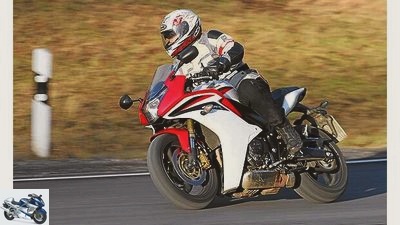
Dentges
With the semi-professional device: variable sharpness, action comes across, high color brilliance.
With good amateur DSLRs (half-format sensors), however, there is an apparent focal length extension due to the system, in technical terms: the crop actuator. This is important when buying a lens, because depending on the model you have to increase the specified focal length by the respective factor (about one and a half times the value). 18 millimeters are then almost 30 millimeters focal length, which still counts as wide angle. This means that the angle of view is larger than the natural impression of the human eye, so that extraordinary perspectives are created. With large focal lengths, objects can be zoomed in nicely, in action photography this is the be-all and end-all, because you can hardly get as close to a racing sports machine, for example, as to a parked bike if you want to take a picture. From this point of view, too, compacts with average maximum focal lengths usually quickly reach their limits well below 200 millimeters. However, an old photographer saying goes: The best pictures are still taken by the camera that is actually included. And unfortunately a complete set of semi-professional equipment including a rucksack can easily weigh eight kilos, which can be a pain in the ass while strolling through town on vacation. Despite all the purchase recommendations in this product test, to be clear and precise: the pictures are still taken by the photographer, not the camera. Even if many devices are now characterized by very well thought-out motif programs (e.g. automatic face recognition, macro function for an optimized display of details, etc.), a good eye and a feeling for the right moment are still crucial in photography. The cameras recommended here are good basic equipment for motorcycle photographers. But if you are not gifted with unbelievable talent, you have to work your way up from apprentice to master, i.e. take courses, read specialist books and try, try, try! In contrast to time-honored analog photography with obligatory film material, digital images cost nothing except storage space.
Finally, the three best tips for motorcycle photography:
- Bring the motorcycle back up from a distance with zoom, the machine or attachments then come across better.
- Try other perspectives, so: Get on your knees and lie down!
- Courage to leave things out: sometimes only show the motorcycle (and driver) in a cut at the edge of the picture.
In this way, even a beginner gets image results that not only Facebook friends appreciate with a “Like!”.
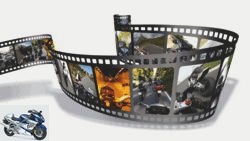
accesories
Product test: onboard cameras
Seven current helmet cameras in the test
read more
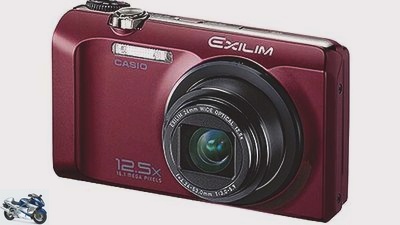
MPS photo studio
1st place: Casio EX-H30.
Conclusion – Casio EX-H30:
Shoots good photos, lots of useful functions, a large telephoto range and is therefore well positioned for motorcycle photography. For under 200 euros by far the best choice for beginners.
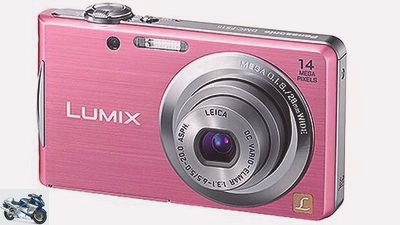
MPS photo studio
2nd place: Panasonic FS 16.
Conclusion – Panasonic FS 16:
Best image quality in its class, beautifully light and compact as well as great workmanship. Sympathetic, very balanced camera that would be even further ahead with a little more focal length.
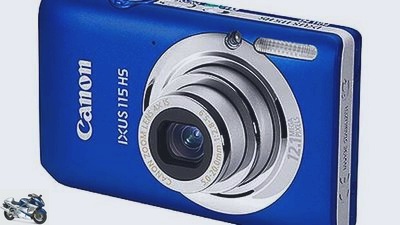
MPS photo studio
3rd place: Canon IXUS 115 HS.
Conclusion – Canon IXUS 115 HS:
Fiddly zoom rocker, hardly usable with motorcycle gloves. Average range of functions, decent equipment and good image quality. Definitely worth the money.
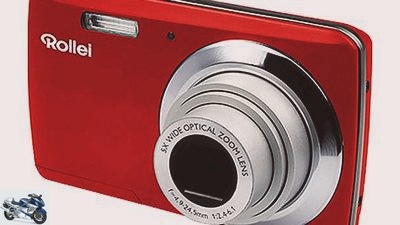
MPS photo studio
4th place: Rollei Powerflex 500.
Conclusion – Rollei Powerflex 500:
The price hit in comparison. For less than 100 euros you can get a very decent snapshot that more than meets the demands of beginners in terms of quality.
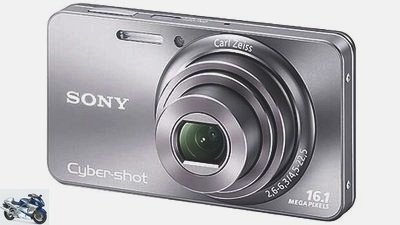
MPS photo studio
5th place: Sony W570.
Conclusion – Sony W570:
Very compact and useful motif programs produce presentable photos. Menu navigation somewhat complicated and noticeably long delay when saving images after triggering.
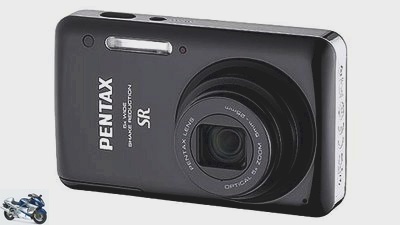
MPS photo studio
6th place: Pentax Optio S1.
Conclusion – Pentax Optio S1:
The investment is low – but so is the equivalent. The quality of the controls is below average, and you have to fight your way through the menu. But makes passable pictures.
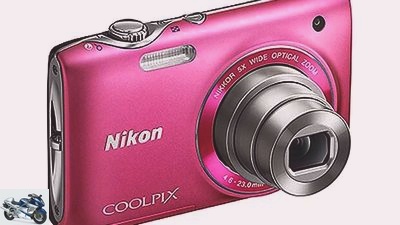
MPS photo studio
7th place: Nikon Coolpix S3100.
Conclusion – Nikon Coolpix S3100:
Still okay as a party shooter, but the adjustment of the focal length is too slow for good pictures of (moving) motorcycles. In low light, the Nikon is completely overwhelmed.
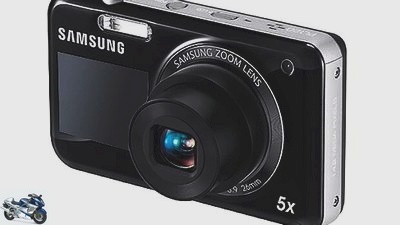
MPS photo studio
8th place: Samsung PL120.
Conclusion – Samsung PL120:
The mini zoom rocker can only be operated with sharp fingernails, the camera reacts very slowly to inputs, and in poor lighting conditions comparatively crude image quality.

accesories
Product test: onboard cameras
Seven current helmet cameras in the test
read more
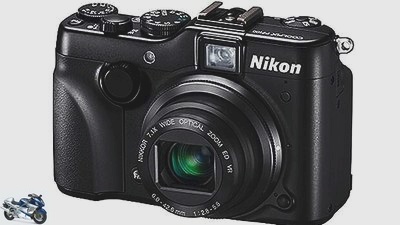
MPS photo studio
1st place: Nikon Coolpix P7100.
Conclusion – Nikon Coolpix P7100:
Awesome image quality, solid workmanship, a large telephoto range and the folding display lead to a narrow but well-deserved victory in points: the best compact motorcycle camera.
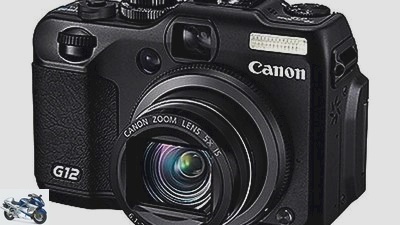
MPS photo studio
2nd place: Canon Powershot G12.
Conclusion – Canon Powershot G12:
Extremely versatile thanks to the flip-swivel display for unusual perspectives. Great imaging performance, good focal length range. First-class, robust camera with a lot of charm.
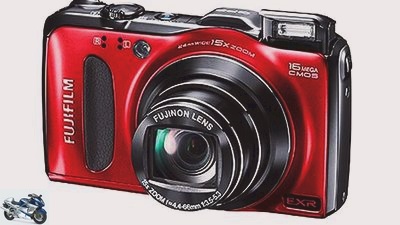
MPS photo studio
3rd place: Fuji Finepix F 600-EXR.
Conclusion – Fuji Finepix F 600-EXR:
The 360 Tele is a great way to capture MotoGP stars in the pits or an approaching machine. Unfortunately, the picture quality is not at the top level. Fair price.
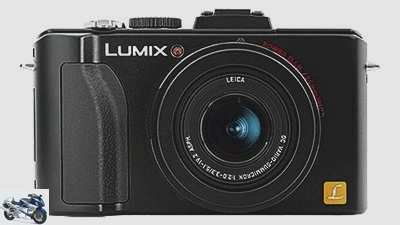
MPS photo studio
4th place: Panasonic LX5.
Conclusion – Panasonic LX5:
Lies comfortably in the hand and delivers the very best image quality, especially in poor lighting conditions. The focal length of up to 90 millimeters is hardly sufficient for action shots.
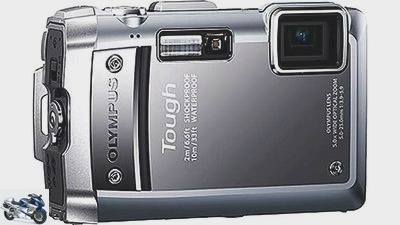
MPS photo studio
5th place: Olympus Tough TG-810.
Conclusion – Olympus Tough TG-810:
Particularly weatherproof and shockproof housing. This is what motorcyclists like, just like the very compact dimensions and the relatively low price. But only second choice in terms of image quality.
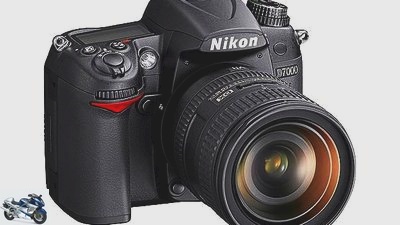
MPS photo studio
Nikon D 7000 SLR camera.
Technically, the D 7000 is the best Nikon offer in the half-format sector. Its image quality is better than that of the Canon EOS 7D under laboratory conditions, but this advantage is negligible in practice. More decisive for demanding photographers is the better noise behavior at higher ISO settings and the double SD memory card slot. Another advantage for motorcycle travelers is the more compact housing compared to the Canon. Disadvantages in the nuance range: The Nikon “only” manages six images per second and its housing is “only” partially made of magnesium alloy. Information: www.nikon.de, housing prices from 890 to 1080 euros, 16 megapixels, full HD film sequences, fill-in flash.
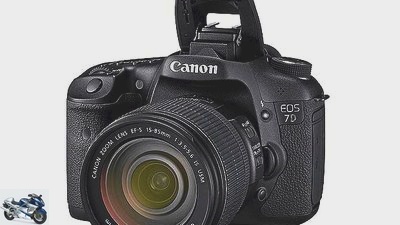
MPS photo studio
Canon EOS 7D SLR camera.
At Canon, the EOS 7D is the best offer in the half-format class. It scores with an automatic sensor cleaner, a dust- and moisture-proof housing made of magnesium alloy and offers action photographers an impressive eight continuous shots per second. A value that is only beaten by the full-format top model EOS 1. The 7D trigger mechanism is designed to withstand 150,000 exposures. The EOS 7D feel is a touch more professional than the Nikon, but the housing is more expensive. Info: www.canon.de, housing prices from 1050 to 1250 euros, 18 megapixels, full HD videos, Life View, fill flash.
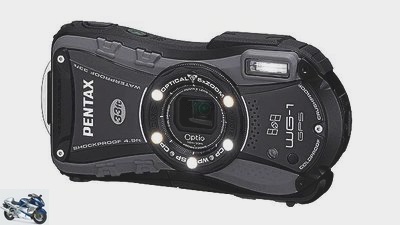
MPS photo studio
Outdoor special camera Pentax WG 1.
Motorcycle adventurers don’t have to worry about this camera. It is waterproof to a depth of ten meters even in salt water, can withstand sandstorms and falls as well as 100 kilos of pressure, can be used down to minus ten degrees, and the special plastic is cleanly processed. Advantages: GPS function, customization functions and many setting options. Disadvantages: poor video function and picture quality below top level in comparison. Other outdoor cameras: Sony Cyber-Shot DSC-TX 10 (330 euros), Panasonic Lumix DMC-FT2 (280 euros), Samsung WP 10 (150 euros), Ricoh PX (190 euros). Info: www.pentax.de. Prices 220 to 250 euros, macro, fill-in LCDs.
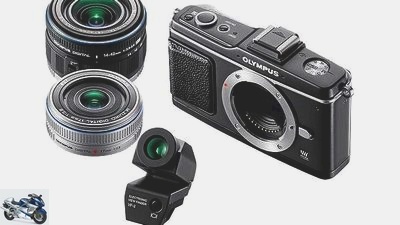
MPS photo studio
System camera: Olympus EPL 2.
So-called system cameras are significantly smaller, lighter and more manageable than single-lens reflex cameras. This term stands for the trend towards mirrorless digital cameras with interchangeable lenses and different sensor sizes and image qualities. Mirror-reflex standards are usually not achieved, but compact camera standards are often exceeded. Interesting for motorcycle travelers due to the large focal length range with minimal dimensions. The Olympus EPL 2 is a representative of the genre, which with its sister models EPL 3 and EPM 1 offers a good price-performance ratio. Info: www.olympus.de, 12 MP, prices z. B. with 14-150 mm kit lens from 498 to 899 euros.

accesories
Product test: onboard cameras
Seven current helmet cameras in the test
read more
Related articles
-
BILLION accesories Product test: onboard cameras Product test: onboard cameras Seven current helmet cameras in the test Motorcycling is action. A hot…
-
Inexpensive touring boots in the product test
MPS photo studio clothing Boots Inexpensive touring boots in the product test Inexpensive touring boots in a comparison test How waterproof and high…
-
Product test: all-round gloves
jkuenstle.de clothing gloves Product test: all-round gloves Product test: gloves All-round gloves in comparison Anyone who wants to play the piano with…
-
Lashing systems in the product test
fotolia 27 pictures mps photo studio 1/27 BGS Spannband Doppelpac, MOTORRAD judgment: satisfactory. Dentges 2/27 Joubert clamping rubber Safe with clever…
-
Product test full face helmets with sun visor
Photo: Herder 51 pictures mps photo studio 1/51 Airoh Movement, MOTORRAD verdict: very good (motorcycle purchase tip). mps photo studio 2/51 HJC RPHA ST,…
-
Product test: neck warmers, balaclavas
MPS photo studio clothing Product test: neck warmers, balaclavas Product test: neck warmer Weather protection for the head, neck and neck Balaclavas,…
-
Earplugs for motorcyclists in the product test
jkuenstle.de 29 pictures jkuenstle.de 1/29 At the latest when the wind sounds while driving as if your ears are not protected at all, you should think…
-
All-round motorcycle gloves up to 50 euros in the product test
van der Ems 17th pictures mps photo studio 1/17 Picture gallery: All-round gloves up to 50 euros in the product test. mps photo studio 2/17 Probiker…
-
mps photo studio clothing gloves Product test: gloves Product test: gloves Gloves for cold days Bright to cool to wet and cold? On Germany’s highest pass…
-
Twelve unique helmet models in the product test
Herder 39 pictures Herder 1/39 Pictures can lie: In truth, we had 12 helmet models in the test, five of them each. mps photo studio 2/39 Lazer Osprey…